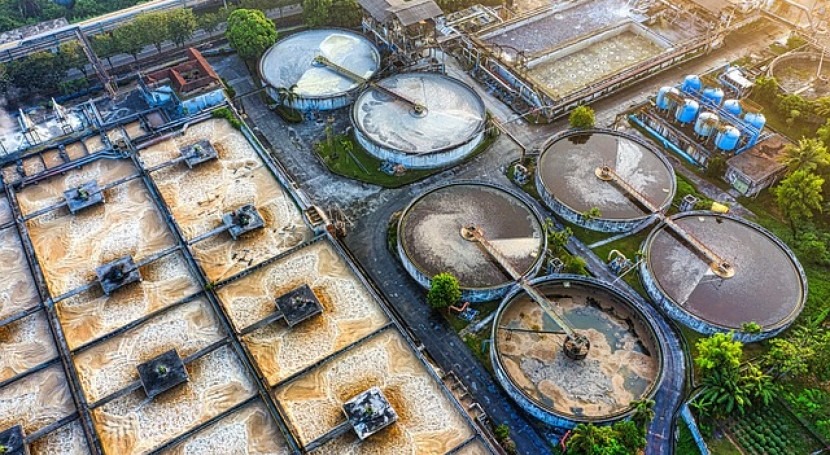Essential Steps in Community Waste Water Treatment Plants
Essential Steps in Community Waste Water Treatment Plants
Blog Article
Strategic Approaches to Improve Drainage Treatment Performance and Minimize Ecological Effect
In the realm of waste water treatment, the pursuit for enhanced performance and minimized environmental effect is a perpetual difficulty that demands critical options. The integration of innovative treatment modern technologies, energy-efficient procedures, source recovery techniques, improved nutrient removal techniques, and smart tracking and control systems stands for a diverse framework for addressing these pressing worries.
Advanced Therapy Technologies
Advanced membrane filtration systems have changed advanced wastewater treatment processes, considerably improving the removal of pollutants. These innovative systems work by forcing water via a semi-permeable membrane layer, efficiently dividing contaminations from the water stream. The membrane layer's tiny pores trap toxins such as germs, infections, and put on hold solids, enabling just cleansed water to go through. This technology has actually verified to be very reliable in getting rid of a wide variety of impurities, consisting of pharmaceuticals, hefty steels, and organic substances, which are usually testing to get rid of with traditional therapy approaches.
Moreover, membrane filtration systems offer many benefits over standard treatment approaches. They need less space, produce higher-quality effluent, and are a lot more resistant to variations in influent water top quality. Additionally, these systems are very functional and can be easily incorporated right into existing therapy plants or made use of as standalone units for decentralized applications. As the demand for clean water remains to climb, the adoption of innovative membrane layer filtration modern technologies is vital to ensure efficient and sustainable wastewater treatment techniques.
Energy-Efficient Procedures
The integration of energy-efficient processes in wastewater therapy systems is vital for enhancing source application and minimizing operational expenses. One key approach to enhancing energy performance in wastewater therapy is the application of advanced aeration systems, such as fine bubble diffusers or surface area aerators, which can improve oxygen transfer efficiency and decrease energy consumption.
Moreover, optimizing procedure control and automation through making use of innovative sensors and checking systems can boost general energy efficiency by changing operations in real-time based upon real need and conditions. Carrying out power audits and routinely checking power efficiency indicators are necessary methods to recognize locations for improvement and track energy-saving campaigns properly. Overall, the adoption of energy-efficient procedures in wastewater treatment not just profits the atmosphere yet also adds to long-term price savings and functional sustainability.
Source Healing Techniques
With an emphasis on enhancing source usage and sustainability in wastewater treatment systems, the implementation of source recuperation methods emerges as a pivotal element in boosting functional performance. Resource healing methods in wastewater treatment include the recognition and extraction of valuable resources from the waste stream, consequently turning what was when considered waste right into a valuable asset. By executing source recovery techniques such as nutrient removal and healing, power generation from organic issue, and the manufacturing of multiple-use water, wastewater therapy plants can lessen ecological impact while taking full advantage of efficiency.

Enhanced Nutrient Removal Strategies
Implementing sophisticated nutrient elimination techniques is crucial for enhancing the performance of wastewater therapy systems. Boosted nutrient elimination plays a crucial duty in decreasing the ecological impact of cured effluent released into water bodies. Among the key strategies used for boosted nutrient elimination is the procedure of biological nutrient removal (BNR), which includes the removal of nitrogen and phosphorus through biological processes. This can be accomplished with the usage of home specialized microbes that can convert nitrogen compounds right into inert nitrogen gas with denitrification, and build up phosphorus within their cells with a process called boosted biological phosphorus removal (EBPR)

Along with BNR, advanced therapy techniques such as membrane layer bioreactors (MBRs) and built marshes can likewise be utilized to enhance nutrient elimination performance. MBRs make use of membranes to attain high-quality effluent standards by properly removing nutrients and put on hold solids. Built marshes simulate natural wetland processes to get rid of nutrients through plant uptake, microbial activity, and sedimentation. By integrating these advanced nutrient elimination strategies into wastewater treatment systems, industries and communities can effectively reduce nutrient contamination and secure the atmosphere.
Smart Surveillance and Control Solution
Utilizing advanced innovation, the integration of wise monitoring and control systems transforms the operational effectiveness of wastewater treatment centers. These systems include sophisticated sensors and information analytics to constantly check vital parameters such as pH degrees, turbidity, dissolved oxygen, and circulation rates in real-time. By gathering and analyzing this information, operators can get important understandings right into the performance of the therapy procedures, making it possible for aggressive changes to optimize therapy efficiency.
Smart surveillance and control systems additionally support remote tracking capacities, enabling operators to access real-time data and control features from off-site places. This remote ease of access boosts functional versatility and responsiveness, enabling speedy treatments in case of system malfunctions or changes in influent top quality. Moreover, the predictive upkeep capacities of these systems help protect against tools failings and minimize downtime, eventually enhancing the total integrity of wastewater treatment see here now operations (Waste Water Treatment).
Final Thought
In verdict, tactical strategies such as advanced therapy modern technologies, energy-efficient procedures, resource healing strategies, enhanced nutrient elimination techniques, and wise monitoring and control systems play an essential role in boosting wastewater therapy efficiency and decreasing ecological influence. By applying these methods, wastewater therapy plants can enhance their general efficiency, lower energy usage, recoup useful sources, and make sure conformity with environmental guidelines. These methods are vital for sustainable and reliable wastewater monitoring techniques.

In final thought, critical strategies such as sophisticated treatment innovations, energy-efficient procedures, resource recuperation methods, enhanced nutrient removal techniques, and smart tracking and control systems play a crucial role in boosting wastewater treatment efficiency and minimizing environmental influence.
Report this page